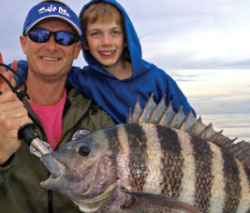Like rod and reel anglers, spear fishermen all have a small handful of go-to stories that they will tell for the rest of their lives. We have all had those catches that you realize are the catch of a lifetime. I had one of those moments recently while diving a murky Southwest Florida reef line in around 100 feet of water. After ducking in and out of several large ledges and holes, I spotted a pair of boulders that created a small cave. I peered in, allowed the dive light to give me some visibility and was greeted by a set of teeth that was almost cartoon-like. Without thought of how I would get this beast out of his lair, I pulled the trigger and hoped for the best. After several minutes of tug-o-war, I finally was rewarded with a 50lb Cubera Snapper and a lifelong memory.
Pursuit of these seemingly prehistoric beasts does present a unique set of challenges, but it is worth trying as long as you have a good game plan. Cubera Snapper reach sizes in excess of100 pounds and every ounce is pure power.
These fish hide well from divers and know how to use structure to their advantage. They rarely give a spear fisherman a second chance to get off a shot, and knowing where to search is the first challenge.
Cubera Snapper are very cautious fish that do not like a lot of attention. If divers commonly hit an area, Cuberas will probablnot be around. Even when you are only a few feet from one, chances are you have no idea. They will hide in the smallest of caves, cracks and crevices. A good dive light is essential for getting visibility in the hole and on the fish. While peering into holes and caves, you search for the great silhouette pressed tightly against the structure. The ominous fangs will usually stand out, if the fish is of any real size. These monsters can shred other reef dwellers with one quick snap of their jaws. Their teeth are not unlike those of their close cousin the mangrove snapper, except much larger!
Due to the nature of a Cubera’s habitat, locating one in its hideaway gives you the best chance of successfully landing a shot. In open water, these fish are shy and quick, but in the protection of a cave they gain confidence in their camouflage and are comfortable to stand their ground.
Once you have spotted your target and taken your shot, the challenge has just begun. Chances are, you just pulled the trigger on a fish that is in or very near a crevice that only he can t in. That spear you were counting as a tool to gain leverage on the fish has now become your greatest obstacle. The spear can act as a barb, lodging itself into the cave walls as the fish tries to retreat deeper into its safe haven. Nothing is more frustrating than having eyes on your prize, but not being able to get it out of a hole because the spear is locked into the side of a rock. The best advice I can give you here is to get your hands on the end of the spear and use that as your pulling point, at least until it clears the structure. Pulling from the end against the fish will increase your chances of bending the shaft, but at least you can keep it from working against you.
Also, make sure you have a trustworthy dive buddy with you. A lot of things can go wrong when your face down against a cave in deep water. You need someone close by to watch your back for other predators, as well as to be available in case you get hung up on the structure or need an extra hand extracting your catch.
I never dive without my Cressi dive knife and there is no better application than the moment you finally get your hands on your prized Cubera. Swiftly sink the knife into the top of the fish’s head and you will end the struggle. This will bring a quick end to any suffering for the fish, as well as keep you from being dragged around the reef by your stringer from a stubborn snapper.
The obstacles to successfully locating, shooting and retrieving a big Cubera Snapper are great, but there are some benefits to pursuing this species as well. Here on the East Coast of Florida, their primary hunting grounds are the warm tropical waters of south Florida, as well as all over the Caribbean. I’ve also taken many in Central America. This means off with the 5mm and 7mm wetsuits, and on with the Cressi Rash Guard or 2.5mm Summer Man Wetsuit. Even in warm water, if you are diving near the reef, I always recommend a rash guard. Incidental contact with coral should be avoided, but from time to time it may happen. It is wise to put a barrier between you and the coral or jelly fish by wearing the Cressi Rash Guard or thin wetsuit; it can make all the difference in the world.
Running a successful Cubera hunt and filling your Grizzly Cooler with tasty snapper takes a lot of planning, team work and still a bit of luck. The reward however, will be great tasting fillets; great pictures with what could easily be most hunters’ largest catch, and life long memories. These prehistoric bottom dwellers do not make it easy on anyone that thinks they have what it takes to bring one home, but with the right set of circumstances, you too could be telling your own story for years to come.





